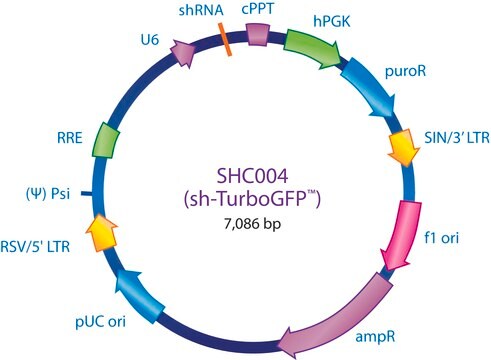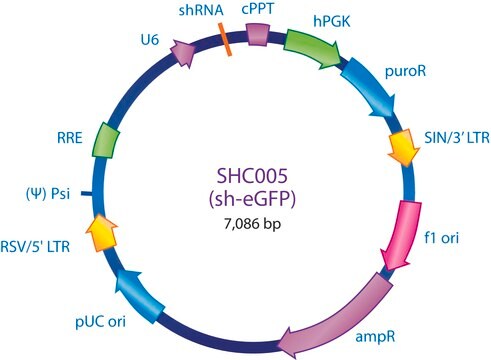SHC003
MISSION® pLKO.1-puro-CMV-TurboGFP™ Positive Control Plasmid DNA
Green fluorescent protein marker to monitor transduction efficiency
Synonim(y):
MISSION® Control Vectors
Zaloguj sięWyświetlanie cen organizacyjnych i kontraktowych
About This Item
Polecane produkty
Poziom jakości
linia produktu
MISSION®
stężenie
500 ng/μL in TE buffer; DNA (10μg of plasmid DNA)
Warunki transportu
dry ice
temp. przechowywania
−20°C
Szukasz podobnych produktów? Odwiedź Przewodnik dotyczący porównywania produktów
Powiązane kategorie
Opis ogólny
The MISSION® TurboGFP™ Control Vector is an 8347 base pair lentivirus plasmid vector that contains a gene encoding TurboGFP™, under the control of the CMV promoter. The TurboGFP™ Control Vector is useful as a positive transfection/transduction control in experiments using the MISSION® shRNA library clones. TurboGFP™ is an improved variant of the green fluorescent protein copGFP cloned from copepoda Pontellina plumata.
Ampicillin and puromycin antibiotic resistance genes provide selection in bacterial or mammalian cells respectively. In addition, self-inactivating replication incompetent viral particles can be produced in packaging cells (HEK293T) by co-transfection with compatible packaging plasmids. The TurboGFP Control Vector is provided as 10 μg of plasmid DNA in Tris-EDTA (TE) buffer at a concentration of 500 ng/μl.
Ampicillin and puromycin antibiotic resistance genes provide selection in bacterial or mammalian cells respectively. In addition, self-inactivating replication incompetent viral particles can be produced in packaging cells (HEK293T) by co-transfection with compatible packaging plasmids. The TurboGFP Control Vector is provided as 10 μg of plasmid DNA in Tris-EDTA (TE) buffer at a concentration of 500 ng/μl.
Zastosowanie
MISSION® pLKO.1-puro-CMV-TurboGFP™ Positive Control Plasmid DNA has been used to construct GATA2 overexpression vector (oeG2), by removing the GFP cassette of this vector at the 5′ NheI and 3′ PstI cloning sites and replacing it with the full-length GATA2 transcript sequence.
To see more application data, protocols, vector maps visit sigma.com/shrna.
Informacje prawne
Use of this product is subject to one or more license agreements. For details, please see http://sigmaaldrich.com/missionlicense.
MISSION is a registered trademark of Merck KGaA, Darmstadt, Germany
TurboBeads is a trademark of TurboBeads LLC
TurboGFP is a trademark of Evrogen Co.
This page may contain text that has been machine translated.
polecane
Numer produktu
Opis
Cennik
Kod klasy składowania
12 - Non Combustible Liquids
Klasa zagrożenia wodnego (WGK)
WGK 1
Certyfikaty analizy (CoA)
Poszukaj Certyfikaty analizy (CoA), wpisując numer partii/serii produktów. Numery serii i partii można znaleźć na etykiecie produktu po słowach „seria” lub „partia”.
Masz już ten produkt?
Dokumenty związane z niedawno zakupionymi produktami zostały zamieszczone w Bibliotece dokumentów.
Inactivation of SDH and FH cause loss of 5hmC and increased H3K9me3 in paraganglioma/pheochromocytoma and smooth muscle tumors.
Hoekstra AS
Oncotarget, 6(36), 38777-38788 (2015)
Selma Zargari et al.
BMC cancer, 20(1), 789-789 (2020-08-21)
MEIS1 (Myeloid ecotropic viral integration site 1) as a homeobox (HOX) transcription factor plays regulatory roles in a variety of cellular processes including development, differentiation, survival, apoptosis and hematopoiesis, as well as stem cell regulation. Few studies have established pluripotency
Min Joo Kim et al.
Scientific reports, 9(1), 13288-13288 (2019-09-19)
Although various chemokines have pro-tumorigenic actions in cancers, the effects of CXCL16 remain controversial. The aim of this study was to investigate the molecular characteristics of CXCL16-expressing papillary thyroid cancers (PTCs). CXCL16 expressions were significantly higher in PTCs than benign
Tris DBA palladium is highly effective against growth and metastasis of pancreatic cancer in an orthotopic model.
Diaz B
Oncotarget, 7(32), 51569-51580 (2016)
Reihaneh Alsadat Mahmoudian et al.
Molecular genetics & genomic medicine, 7(7), e00746-e00746 (2019-05-16)
MEIS1 (Myeloid ecotropic viral integration site 1), as a homeobox (HOX) transcription factor, has a dual function in different types of cancer. Although numerous roles are proposed for MEIS1 in differentiation, stem cell function, gastrointestinal development and tumorigenesis, the involved
Nasz zespół naukowców ma doświadczenie we wszystkich obszarach badań, w tym w naukach przyrodniczych, materiałoznawstwie, syntezie chemicznej, chromatografii, analityce i wielu innych dziedzinach.
Skontaktuj się z zespołem ds. pomocy technicznej






